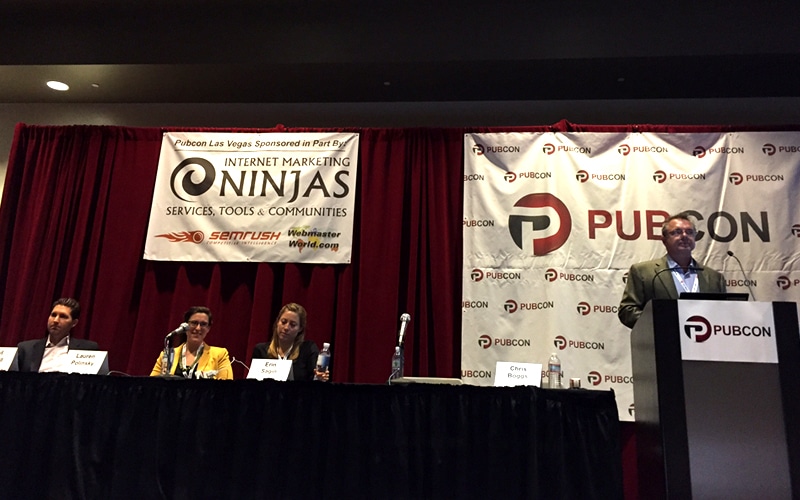Las Vegas may be known as Sin City, but it was only filled with goodness last week as talented digital marketers from far and wide flocked to PubCon to learn the latest techniques in the search, social, content and data realm.
With five keynotes and nine concurrent tracks running over the course of three days, there was much to hear from our industry’s expert speakers. Here at AIMCLEAR, these were the tips that made it onto our Top 5 All-Star list of sessions attended.
1. A quick cure for writer’s block
There were writing tips aplenty in the Building Great Content session with Stoney deGeyter, Anne Smarty and Loren Baker.
It’s not uncommon for writers to experience a bout of writer’s block, but not to fear. If you’re struggling for new content ideas, there are a multitude of creative ways to repurpose, atomize and transform old content to make it newer, more exciting and even better than the first time around. Some of these tips include:
- Rewriting old blog posts with a new take
- Turning a blog comment into a post
- Expanding tweets into a full post
- Turning one blog post into many posts
- Publishing a fleshed out email response
There are also ways to help make your content more meaningful by re-packaging your content into new formats to reach new audiences. Examples include:
- Breaking videos down into other formats like vines, animated gifs & podcasts
- Transcribing your videos and turning them into blog posts
- Turning a presentation into a written post
- Transforming factual posts into infographics
- Chopping up your infographics into infograms for social distribution on 3rd party sites
- Turning related blog topics into an e-book
2. Mobile conversion is not just about click-to-call
By 2018, mobile search will drive 73 billion inbound calls to advertisers. But in the mobile conversion session with Daryl Colwell, Lauren Polinsky and Erin Sagin, we were reminded not to assume that people only want a click-to-call option on their mobile. In fact, content is just as important to people on their mobile device as it is on desktop, particularly when people aren’t yet at the stage of wanting to speak with someone.
Contrary to popular belief, mobile users will respond to a relevant call-to-action that is placed in front of them – yes, even a lead gen form – because many visitors who come to your mobile site will still be in learn-mode and not yet ready to buy. So why aren’t we seeing more of this?
Part of the issue is that most mobile landing pages aren’t keeping up with today’s needs and capabilities. It’s time to shake this up. Understanding the intent of your visitors (e.g. based upon search queries) is an important first step. Also, testing is just as important for mobile landing page optimization as it is on desktop but is often neglected. Local (NAP) schema markup and micro-formats also need to be applied. And most importantly, don’t forget to cookie your mobile visitors for further retargeting and content nurture opportunities. After all, no lead should be left behind.
3. It’s not about how big your data is; it’s how you use it
When embracing big data and analytics, Rebecca Murtagh reminded us that although data is plentiful, information today is so vast and fast moving that it can become very overwhelming, very quickly. This also increases the risk of analysis paralysis in many organizations.
Since leaders are 116 percent more likely to make decisions based on big data, it’s our job as digital marketers to ensure we are not just collecting masses of data, but using it in ways that help inform good ROI decisions. In particular, data should be analyzed to help inform:
- Laser-focused targeting
- Better communication through message personalization
- Smarter use of automation
- Efficient allocation of resources
4. Our biggest opportunity is in the smallest moments
It may not be surprising to hear that people are checking their phones around 150 times throughout the day. This checking behavior is occurring in small bursts, with an average of only 1m 10s being spent per session, giving rise to many micro-moment opportunities for marketers to capture consumers during a time of need – whether people are looking to find a place for brunch, watching how to fix a faucet video, or researching vacation destinations. There are literally millions of these moments happening every day.
According to Matt Rogers from Google, some moments will matter more to marketers than others. Marketing in the right moment is dependent on the intent, context and immediacy of the situation:
- “I want-to-watch moments: 53% of online video viewers watch to be inspired or entertained
- I want-to-know moments: 65% of online consumers look up more information online now versus a few years ago
- I want-to-go moments: 2X increase in “near me” search interest in the past year
- I want-to-do moments: 91% of smartphone users turn to their phones for ideas while doing a task
- I want-to-buy moments: 82% of smartphone users consult their phones while in a store deciding what to buy”
It is up to us as digital marketers to connect the dots and win the moments that matter. Tips for doing this include spending the time to research and identify key micro-moments for your customers, delivering on those identified needs in-the-moment, and finally measuring the moments that matter so that you can continue to adapt and improve every customer experience.
5. SEO is about audience, not algorithms
With all the constant changes and updates that Google are making to their algorithms (15 in 2014 alone), SEOs often become obsessed over the next major Penguin or Panda hit and are continuously playing catch up with each change.
Rather than spending time and effort on figuring out how search engines work and ways to beat it, Wil Reynolds highlighted the need to understand how people work and then use a combination of paid and organic approaches to create great experiences.
Rather than studying algorithms, instead study the psychology of the human mind. A better understanding of your customers will allow you to craft better, more relevant content in the right context, and from this drive the right integrated search and social strategies. Ultimately, optimization should be about understanding and catering to the needs of your audience versus catering to the needs of the search engines.
Year-after-year, Pubcon continues to deliver a jam-packed agenda that once again did not disappoint. But with so many hot topic sessions going on at once, we know that our list only touches the slightest tip of the iceberg. So, Pubcon attendees, what did you learn that made your All-Star list?













